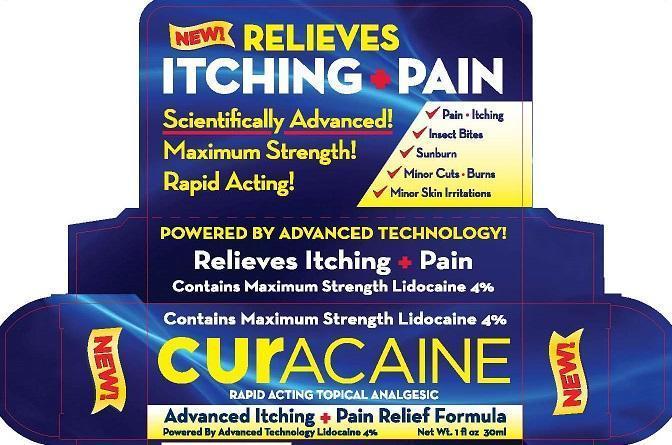Curacaine | Lidocaine Cream while Breastfeeding

What is Curacaine | Lidocaine Cream used for?
Purpose: topical analgesic Keep out of reach of children. If swallowed, get medical help or contact a Poison Control Center right away. Uses for the temporary relief of pain and itching insect bites sunburn minor cuts scrapes burns minor skin irritations Warnings For external use only When using this product Keep out of eyes. Rinse with water to remove. Do not use in large quantities, particularly over raw surfaces or blistered areas. If pregnant or breast feeding, ask a health professional before use. Directions Adults and children 2 years of age and older: Apply to affected area not more than 3 to 4 times daily. Children under 2 years of age: consult a doctor. Inactive Ingredients Caprylyl Glycol, Cetearyl Alcohol, Clyclopentasiloxane, Deionized water, Dimethyl Sulone, Glycerin, Hexylene Glycol, Phenoxyethanol, Polysorbate 20, Polysorbate 60, Propylene Glycol, Simmondsia Chinensis (Jojoba) Seed Oil, Sodium hyaluronate, Sodium Lauryl Sulfate, Stearic Acid, Tetrasodium EDTA, Tocopheryl Acetate Stop use and ask a doctor if conditions worsens, or, if symptoms persist for more than 7 days, or clear up and occur again within a few days, discontinue use of the product and consult a doctor.
I am breastfeeding mother and I am using Curacaine | Lidocaine Cream. Can it have any bad effect on my kid? Shall I search for better alternative?

Curacaine | Lidocaine Cream Breastfeeding Analsys
Lidocaine while Breastfeeding
SafeCAS Number: 137-58-6
Compatible with breastfeeding no matter the multiple ways it can be used: anesthetic, anti-arrhythmic, or anti-epileptic drug. Excreted into breast milk in non-significant amount with no side effects on breastfed infants from treated mothers. As a topical anesthetic (dermatologic, dental-stomatologic, ophtalmotologic and otologic preparations) it has an almost nil systemic absorption. Avoid using it on the nipple, but if necessary do it after the breast feed, wipe it out and rinse with water before the next feed, An euptectic mixture with added Prilocaine (EMLA) is used for dermatologic anesthesia. There is an increased risk of Methemoglobinemia when applied on large surfaces or taken by mouth. Intrapartum anesthesia may delay the onset of phase II of Lactogenesis or milk coming-in. The American Academy of Pediatrics rates it usually compatible with Breastfeeding.
Curacaine | Lidocaine Cream Breastfeeding Analsys - 2
Lidocaine while Breastfeeding
CAS Number: 137-58-6

Lidocaine concentrations in milk during continuous IV infusion, epidural administration and in high doses as a local anesthetic are low and the lidocaine is poorly absorbed by the infant. Lidocaine is not expected to cause any adverse effects in breastfed infants. No special precautions are required.[1][2][3] Lidocaine labor and delivery with other anesthetics and analgesics has been reported by some to interfere with breastfeeding. However, this assessment is controversial and complex because of the many different combinations of drugs, dosages and patient populations studied as well as the variety of techniques used and deficient design of many of the studies. Overall it appears that with good breastfeeding support epidural lidocaine with or without fentanyl or one of its derivatives has little or no adverse effect on breastfeeding success.[4][5][6][7][8] Labor pain medication may delay the onset of lactation.

I already used Curacaine | Lidocaine Cream and meanwhile I breastfed my baby should I be concerned?
As usage of Curacaine | Lidocaine Cream is mostly safe while breastfeeding hence there should not be any concern. In case of any change in behavior or health of your baby you should inform your health care provider about usage of Curacaine | Lidocaine Cream else no further action is required.
I am nursing mother and my doctor has suggested me to use Curacaine | Lidocaine Cream, is it safe?
Usage of Curacaine | Lidocaine Cream is safe for nursing mothers and baby, No worries.
If I am using Curacaine | Lidocaine Cream, will my baby need extra monitoring?
No
Who can I talk to if I have questions about usage of Curacaine | Lidocaine Cream in breastfeeding?
US
National Womens Health and Breastfeeding Helpline: 800-994-9662 (TDD 888-220-5446) 9 a.m. and 6 p.m. ET, Monday through Friday
UK
National Breastfeeding Helpline: 0300-100-0212 9.30am to 9.30pm, daily
Association of Breastfeeding Mothers: 0300-330-5453
La Leche League: 0345-120-2918
The Breastfeeding Network supporter line in Bengali and Sylheti: 0300-456-2421
National Childbirth Trust (NCT): 0300-330-0700
Australia
National Breastfeeding Helpline: 1800-686-268 24 hours a day, 7 days a week
Canada
Telehealth Ontario for breastfeeding: 1-866-797-0000 24 hours a day, 7 days a week
